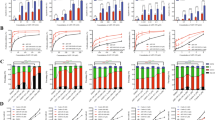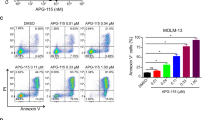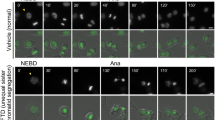Abstract
AZD1775 targets the cell cycle checkpoint kinase Wee1 and potentiates genotoxic agent cytotoxicity through p53-dependent or -independent mechanisms. Here, we report that AZD1775 interacted synergistically with histone deacetylase inhibitors (HDACIs, for example, Vorinostat), which interrupt the DNA damage response, to kill p53-wild type (wt) or -deficient as well as FLT3-ITD leukemia cells in association with pronounced Wee1 inhibition and diminished cdc2/Cdk1 Y15 phosphorylation. Similarly, Wee1 shRNA knockdown significantly sensitized cells to HDACIs. Although AZD1775 induced Chk1 activation, reflected by markedly increased Chk1 S296/S317/S345 phosphorylation leading to inhibitory T14 phosphorylation of cdc2/Cdk1, these compensatory responses were sharply abrogated by HDACIs. This was accompanied by premature mitotic entry, multiple mitotic abnormalities and accumulation of early S-phase cells displaying increased newly replicated DNA, culminating in robust DNA damage and apoptosis. The regimen was active against patient-derived acute myelogenous leukemia (AML) cells harboring either wt or mutant p53 and various next-generation sequencing-defined mutations. Primitive CD34+/CD123+/CD38− populations enriched for leukemia-initiating progenitors, but not normal CD34+ hematopoietic cells, were highly susceptible to this regimen. Finally, combining AZD1775 with Vorinostat in AML murine xenografts significantly reduced tumor burden and prolonged animal survival. A strategy combining Wee1 with HDACI inhibition warrants further investigation in AML with poor prognostic genetic aberrations.
This is a preview of subscription content, access via your institution
Access options
Subscribe to this journal
Receive 12 print issues and online access
$259.00 per year
only $21.58 per issue
Buy this article
- Purchase on SpringerLink
- Instant access to full article PDF
Prices may be subject to local taxes which are calculated during checkout








Similar content being viewed by others
References
Welch JS, Ley TJ, Link DC, Miller CA, Larson DE, Koboldt DC et al. The origin and evolution of mutations in acute myeloid leukemia. Cell 2012; 150: 264–278.
Levis M . FLT3 mutations in acute myeloid leukemia: what is the best approach in 2013?. Hematology Am Soc Hematol Educ Program 2013; 2013: 220–226.
Roboz GJ, Rosenblat T, Arellano M, Gobbi M, Altman JK, Montesinos P et al. International randomized phase III study of elacytarabine versus investigator choice in patients with relapsed/refractory acute myeloid leukemia. J Clin Oncol 2014; 32: 1919–1926.
Grant S, Dai Y . Histone deacetylase inhibitors and rational combination therapies. Adv Cancer Res 2012; 116: 199–237.
Bots M, Verbrugge I, Martin BP, Salmon JM, Ghisi M, Baker A et al. Differentiation therapy for the treatment of t(8;21) acute myeloid leukemia using histone deacetylase inhibitors. Blood 2014; 123: 1341–1352.
Bose P, Grant S . Orphan drug designation for pracinostat, volasertib and alvocidib in AML. Leuk Res 2014; 38: 862–865.
Grant S, Easley C, Kirkpatrick P . Vorinostat. Nat Rev Drug Discov 2007; 6: 21–22.
Bose P, Dai Y, Grant S . Histone deacetylase inhibitor (HDACI) mechanisms of action: Emerging insights. Pharmacol Ther 2014; 143: 323–336.
Lee JH, Choy ML, Ngo L, Foster SS, Marks PA . Histone deacetylase inhibitor induces DNA damage, which normal but not transformed cells can repair. Proc Natl Acad Sci USA 2010; 107: 14639–14644.
Koprinarova M, Botev P, Russev G . Histone deacetylase inhibitor sodium butyrate enhances cellular radiosensitivity by inhibiting both DNA nonhomologous end joining and homologous recombination. DNA Repair (Amst) 2011; 10: 970–977.
Brazelle W, Kreahling JM, Gemmer J, Ma Y, Cress WD, Haura E et al. Histone deacetylase inhibitors downregulate checkpoint kinase 1 expression to induce cell death in non-small cell lung cancer cells. PLoS One 2010; 5: e14335.
Dai Y, Chen S, Kmieciak M, Zhou L, Lin H, Pei XY et al. The novel Chk1 inhibitor MK-8776 sensitizes human leukemia cells to HDAC inhibitors by targeting the intra-S checkpoint and DNA replication and repair. Mol Cancer Ther 2013; 12: 878–889.
Dai Y, Grant S . New insights into checkpoint kinase 1 in the DNA damage response signaling network. Clin Cancer Res 2010; 16: 376–383.
Kachhap SK, Rosmus N, Collis SJ, Kortenhorst MS, Wissing MD, Hedayati M et al. Downregulation of homologous recombination DNA repair genes by HDAC inhibition in prostate cancer is mediated through the E2F1 transcription factor. PLoS One 2010; 5: e11208.
Fan J, Li L, Small D, Rassool F . Cells expressing FLT3/ITD mutations exhibit elevated repair errors generated through alternative NHEJ pathways: implications for genomic instability and therapy. Blood 2010; 116: 5298–5305.
Petruccelli LA, Pettersson F, Del Rincon SV, Guilbert C, Licht JD, Miller WH Jr . Expression of leukemia-associated fusion proteins increases sensitivity to histone deacetylase inhibitor-induced DNA damage and apoptosis. Mol Cancer Ther 2013; 12: 1591–1604.
Gaymes TJ, Padua RA, Pla M, Orr S, Omidvar N, Chomienne C et al. Histone deacetylase inhibitors (HDI) cause DNA damage in leukemia cells: a mechanism for leukemia-specific HDI-dependent apoptosis?. Mol Cancer Res 2006; 4: 563–573.
Sorensen CS, Syljuasen RG . Safeguarding genome integrity: the checkpoint kinases ATR, CHK1 and WEE1 restrain CDK activity during normal DNA replication. Nucleic Acids Res 2012; 40: 477–486.
Porter CC, Kim J, Fosmire S, Gearheart CM, van LA, Baturin D et al. Integrated genomic analyses identify WEE1 as a critical mediator of cell fate and a novel therapeutic target in acute myeloid leukemia. Leukemia 2012; 26: 1266–1276.
Tibes R, Bogenberger JM, Chaudhuri L, Hagelstrom RT, Chow D, Buechel ME et al. RNAi screening of the kinome with cytarabine in leukemias. Blood 2012; 119: 2863–2872.
Do K, Doroshow JH, Kummar S . Wee1 kinase as a target for cancer therapy. Cell Cycle 2013; 12: 3159–3164.
Aarts M, Sharpe R, Garcia-Murillas I, Gevensleben H, Hurd MS, Shumway SD et al. Forced mitotic entry of S-phase cells as a therapeutic strategy induced by inhibition of WEE1. Cancer Discov 2012; 2: 524–539.
Katayama K, Fujita N, Tsuruo T . Akt/protein kinase B-dependent phosphorylation and inactivation of WEE1Hu promote cell cycle progression at G2/M transition. Mol Cell Biol 2005; 25: 5725–5737.
Mizuarai S, Yamanaka K, Itadani H, Arai T, Nishibata T, Hirai H et al. Discovery of gene expression-based pharmacodynamic biomarker for a p53 context-specific anti-tumor drug Wee1 inhibitor. Mol Cancer 2009; 8: 34.
Hirai H, Iwasawa Y, Okada M, Arai T, Nishibata T, Kobayashi M et al. Small-molecule inhibition of Wee1 kinase by MK-1775 selectively sensitizes p53-deficient tumor cells to DNA-damaging agents. Mol Cancer Ther 2009; 8: 2992–3000.
Wattel E, Preudhomme C, Hecquet B, Vanrumbeke M, Quesnel B, Dervite I et al. p53 mutations are associated with resistance to chemotherapy and short survival in hematologic malignancies. Blood 1994; 84: 3148–3157.
Christiansen DH, Andersen MK, Pedersen-Bjergaard J . Mutations with loss of heterozygosity of p53 are common in therapy-related myelodysplasia and acute myeloid leukemia after exposure to alkylating agents and significantly associated with deletion or loss of 5q, a complex karyotype, and a poor prognosis. J Clin Oncol 2001; 19: 1405–1413.
De Witt Hamer PC, Mir SE, Noske D, Van Noorden CJ, Wurdinger T . WEE1 kinase targeting combined with DNA-damaging cancer therapy catalyzes mitotic catastrophe. Clin Cancer Res 2011; 17: 4200–4207.
Mir SE, De Witt Hamer PC, Krawczyk PM, Balaj L, Claes A, Niers JM et al. In silico analysis of kinase expression identifies WEE1 as a gatekeeper against mitotic catastrophe in glioblastoma. Cancer Cell 2010; 18: 244–257.
Smith J, Tho LM, Xu N, Gillespie DA . The ATM-Chk2 and ATR-Chk1 pathways in DNA damage signaling and cancer. Adv Cancer Res 2010; 108: 73–112.
Booher RN, Holman PS, Fattaey A . Human Myt1 is a cell cycle-regulated kinase that inhibits Cdc2 but not Cdk2 activity. J Biol Chem 1997; 272: 22300–22306.
Darzynkiewicz Z, Traganos F, Zhao H, Halicka HD, Skommer J, Wlodkowic D . Analysis of individual molecular events of DNA damage response by flow- and image-assisted cytometry. Methods Cell Biol 2011; 103: 115–147.
Hirose T, Sowa Y, Takahashi S, Saito S, Yasuda C, Shindo N et al. p53-independent induction of Gadd45 by histone deacetylase inhibitor: coordinate regulation by transcription factors Oct-1 and NF-Y. Oncogene 2003; 22: 7762–7773.
Hansen RS, Thomas S, Sandstrom R, Canfield TK, Thurman RE, Weaver M et al. Sequencing newly replicated DNA reveals widespread plasticity in human replication timing. Proc Natl Acad Sci USA 2010; 107: 139–144.
Eriksson D, Lofroth PO, Johansson L, Riklund KA, Stigbrand T . Cell cycle disturbances and mitotic catastrophes in HeLa Hep2 cells following 2.5 to 10 Gy of ionizing radiation. Clin Cancer Res 2007; 13 (18 Pt 2): 5501s–5508ss.
Jordan CT, Upchurch D, Szilvassy SJ, Guzman ML, Howard DS, Pettigrew AL et al. The interleukin-3 receptor alpha chain is a unique marker for human acute myelogenous leukemia stem cells. Leukemia 2000; 14: 1777–1784.
Batey MA, Zhao Y, Kyle S, Richardson C, Slade A, Martin NM et al. Preclinical evaluation of a novel ATM inhibitor, KU59403, in vitro and in vivo in p53 functional and dysfunctional models of human cancer. Mol Cancer Ther 2013; 12: 959–967.
Reaper PM, Griffiths MR, Long JM, Charrier JD, Maccormick S, Charlton PA et al. Selective killing of ATM- or p53-deficient cancer cells through inhibition of ATR. Nat Chem Biol 2011; 7: 428–430.
Kreahling JM, Foroutan P, Reed D, Martinez G, Razabdouski T, Bui MM et al. Wee1 inhibition by MK-1775 leads to tumor inhibition and enhances efficacy of gemcitabine in human sarcomas. PLoS One 2013; 8: e57523.
Bridges KA, Hirai H, Buser CA, Brooks C, Liu H, Buchholz TA et al. MK-1775, a novel Wee1 kinase inhibitor, radiosensitizes p53-defective human tumor cells. Clin Cancer Res 2011; 17: 5638–5648.
Hirai H, Arai T, Okada M, Nishibata T, Kobayashi M, Sakai N et al. MK-1775, a small molecule Wee1 inhibitor, enhances anti-tumor efficacy of various DNA-damaging agents, including 5-fluorouracil. Cancer Biol Ther 2010; 9: 514–522.
Foroutan P, Kreahling JM, Morse DL, Grove O, Lloyd MC, Reed D et al. Diffusion MRI and novel texture analysis in osteosarcoma xenotransplants predicts response to anti-checkpoint therapy. PLoS One 2013; 8: e82875.
Harris PS, Venkataraman S, Alimova I, Birks DK, Balakrishnan I, Cristiano B et al. Integrated genomic analysis identifies the mitotic checkpoint kinase WEE1 as a novel therapeutic target in medulloblastoma. Mol Cancer 2014; 13: 72.
Rajeshkumar NV, de OE, Ottenhof N, Watters J, Brooks D, Demuth T et al. MK-1775, a potent Wee1 inhibitor, synergizes with gemcitabine to achieve tumor regressions, selectively in p53-deficient pancreatic cancer xenografts. Clin Cancer Res 2011; 17: 2799–2806.
Carrassa L, Chila R, Lupi M, Ricci F, Celenza C, Mazzoletti M et al. Combined inhibition of Chk1 and Wee1: in vitro synergistic effect translates to tumor growth inhibition in vivo. Cell Cycle 2012; 11: 2507–2517.
Beck H, Nahse-Kumpf V, Larsen MS, O'Hanlon KA, Patzke S, Holmberg C et al. Cyclin-dependent kinase suppression by WEE1 kinase protects the genome through control of replication initiation and nucleotide consumption. Mol Cell Biol 2012; 32: 4226–4236.
Kellogg DR . Wee1-dependent mechanisms required for coordination of cell growth and cell division. J Cell Sci 2003; 116 (Pt 24): 4883–4890.
Krajewska M, Heijink AM, Bisselink YJ, Seinstra RI, Sillje HH, de Vries EG et al. Forced activation of Cdk1 via wee1 inhibition impairs homologous recombination. Oncogene 2013; 32: 3001–3008.
Weisberg E, Nonami A, Chen Z, Liu F, Zhang J, Sattler M et al. Identification of Wee1 as a novel therapeutic target for mutant RAS-driven acute leukemia and other malignancies. Leukemia 2014; e-pub ahead of print 5 May 2014; doi:10.1038/leu.2014.149.
The Cancer Genome Atlas Research Network. Genomic and epigenomic landscapes of adult de novo acute myeloid leukemia. N Engl J Med 2013; 368: 2059–2074.
Vitale I, Galluzzi L, Castedo M, Kroemer G . Mitotic catastrophe: a mechanism for avoiding genomic instability. Nat Rev Mol Cell Biol 2011; 12: 385–392.
Beck H, Nahse V, Larsen MS, Groth P, Clancy T, Lees M et al. Regulators of cyclin-dependent kinases are crucial for maintaining genome integrity in S phase. J Cell Biol 2010; 188: 629–638.
Varmeh S, Manfredi JJ . Inappropriate activation of cyclin-dependent kinases by the phosphatase Cdc25b results in premature mitotic entry and triggers a p53-dependent checkpoint. J Biol Chem 2009; 284: 9475–9488.
Hans F, Dimitrov S . Histone H3 phosphorylation and cell division. Oncogene 2001; 20: 3021–3027.
Kreahling JM, Gemmer JY, Reed D, Letson D, Bui M, Altiok S . MK1775, a selective Wee1 inhibitor, shows single-agent antitumor activity against sarcoma cells. Mol Cancer Ther 2012; 11: 174–182.
Guertin AD, Li J, Liu Y, Hurd MS, Schuller AG, Long B et al. Preclinical evaluation of the WEE1 inhibitor MK-1775 as single-agent anticancer therapy. Mol Cancer Ther 2013; 12: 1442–1452.
Thompson R, Eastman A . The cancer therapeutic potential of Chk1 inhibitors: how mechanistic studies impact on clinical trial design. Br J Clin Pharmacol 2013; 76: 358–369.
Lee J, Kumagai A, Dunphy WG . Positive regulation of Wee1 by Chk1 and 14-3-3 proteins. Mol Biol Cell 2001; 12: 551–563.
Davies KD, Cable PL, Garrus JE, Sullivan FX, von C I, Huerou YL et al. Chk1 inhibition and Wee1 inhibition combine synergistically to impede cellular proliferation. Cancer Biol Ther 2011; 12: 788–796.
Chaudhuri L, Vincelette ND, Koh BD, Naylor RM, Flatten KS, Peterson KL et al. CHK1 and WEE1 inhibition combine synergistically to enhance therapeutic efficacy in acute myeloid leukemia ex vivo. Haematologica 2014; 99: 688–696.
Acknowledgements
This work was supported by the National Institutes of Health (Grant CA93738, CA100866, CA167708, P50 CA142509, and P50 CA130805) and the Leukemia and Lymphoma Society of America (Grant R6238 and 6472-15). Plasmid preparation was performed at the VCU Macromolecule Core Facility, supported, in part, with funding from NIH-NCI Cancer Center Core Grant 5P30CA016059-29; Confocal microscopies were performed at the VCU Department of Anatomy and Neurobiology Microscopy Facility, supported, in part, with funding from NIH-NINDS Center Core Grant 5P30NS047463.
Author Contributions
YD and SG conceptualized research and formed the hypothesis of this paper; SC and YD designed, performed experiments, analyzed data; LZ, YZ, SC, YL, HL and YD performed the in vitro research and collected data; LZ, YZ, SC and YD performed animal studies and collected data; MK designed, performed and analyzed flow cytometry work; KAR, CID and AF-G provided patient samples, or performed and analyzed NGS work; YD and SG wrote the manuscript.
Author information
Authors and Affiliations
Corresponding authors
Ethics declarations
Competing interests
The authors declare no conflict of interest.
Additional information
Supplementary Information accompanies this paper on the Leukemia website
Supplementary information
Rights and permissions
About this article
Cite this article
Zhou, L., Zhang, Y., Chen, S. et al. A regimen combining the Wee1 inhibitor AZD1775 with HDAC inhibitors targets human acute myeloid leukemia cells harboring various genetic mutations. Leukemia 29, 807–818 (2015). https://doi.org/10.1038/leu.2014.296
Received:
Revised:
Accepted:
Published:
Issue Date:
DOI: https://doi.org/10.1038/leu.2014.296



